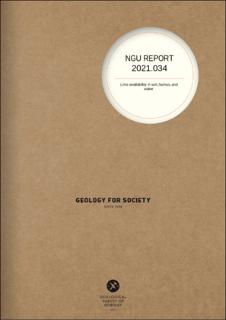| dc.contributor.author | Acosta-Gongora, Pedro | |
| dc.contributor.author | Finne, Tor Erik | |
| dc.contributor.author | Flem, Belinda | |
| dc.contributor.author | Andersson, Malin | |
| dc.contributor.author | Heldal, Tom | |
| dc.date.accessioned | 2022-02-28T07:55:52Z | |
| dc.date.available | 2022-02-28T07:55:52Z | |
| dc.date.issued | 2021 | |
| dc.identifier.issn | 0800-3416 | |
| dc.identifier.uri | https://hdl.handle.net/11250/2981587 | |
| dc.description.abstract | Calcium (herein a proxy for lime) is an important nutrient for plants and its availability within an area can favour the occurrence and\/or dominance of certain plant species. Regional and local scale studies were carried out in the northern Trøndelag county to assess calcium availability in different media (soil, humus, and water) and within areas located below and above the marine limit. This study used stream water (only regional), humus, and mineral soil data to quantify the availability of calcium. These datasets were combined with the previously defined calcium availability index for bedrock units to elaborate an integrated calcium availability map using Fuzzy Logic and Index Overlay approaches.Calcium availability in soil and humus from areas below and above the marine limit are undistinguishable. The stream water samples located below the marine limit are slightly enriched in calcium relative to those taken above, but this is likely due to contamination derived from nearby farming. Notably, the spatial correlation between calcium in humus and bedrock is greater than that of calcium in soil and bedrock regardless of the survey scale. This suggests that for some elements, humus may be a better media to characterize the underlying lithologies, which may have important implications for mineral exploration surveys and environmental assessments. Our methodology is validated by the fact that in both surveys (regional and local), lime-rich forest types were mainly contained in areas having intermediate to high calcium availability values in different media and the integrated calcium availability map. Despite its limitations, the methodology described in this study provides a first order tool to identify forest types that commonly occur in areas with low and high calcium availability. | |
| dc.language.iso | nor | |
| dc.publisher | Norges geologiske undersøkelse | |
| dc.relation.ispartofseries | NGU-Rapport (2021.034) | |
| dc.rights | Navngivelse 4.0 Internasjonal | |
| dc.rights.uri | http://creativecommons.org/licenses/by/4.0/deed.no | |
| dc.subject | ØKOLOGI | |
| dc.subject | GEOKJEMI | |
| dc.subject | KALK | |
| dc.title | Lime availability in soil, humus, and water | |
| dc.type | Report | |
| dc.description.localcode | 67531 | |
| dc.source.pagenumber | 34 s. | |
| dc.relation.project | 390800 | |

